 KANSAS CITY — Concern about fresh water scarcity continues to drive change throughout the food production and processing industries. In addition to local governments and individual companies taking a more proactive approach to conservation, risk management tools are emerging to help business leaders assess and hedge against uncertainty. Such tools must be further developed to aid producers and manufacturers in risk management.
KANSAS CITY — Concern about fresh water scarcity continues to drive change throughout the food production and processing industries. In addition to local governments and individual companies taking a more proactive approach to conservation, risk management tools are emerging to help business leaders assess and hedge against uncertainty. Such tools must be further developed to aid producers and manufacturers in risk management.
Ceres, a non-profit that works with investors and companies to identify sustainable solutions to climate change, held a webinar Aug. 28 about the issue of water scarcity. Maarten Gischler, senior water adviser for the government of The Netherlands, estimated that the true economic cost of fresh water is four to eight times higher than what businesses currently pay.
The threat of significantly higher costs on the horizon will accelerate development of risk management tools. One such tool was introduced in mid-September by the CME Group, Chicago, and Nasdaq, New York. The Nasdaq Veles California Water Index future is intended to give agricultural, commercial and municipal water users greater transparency, price discovery and risk transfer.
“With nearly two-thirds of the world’s population expected to face water shortages by 2025, water scarcity presents a growing risk for businesses and communities around the world, and particularly for the $1.1 billion California water market,” said Tim McCourt, global head of equity index and alternative investment products for the CME Group. “Developing risk management tools that address growing environmental concerns is increasingly important to CME Group.”
The true economic cost of fresh water is estimated to be four to eight time higher than what businesses currently pay.
The futures market will help create a forward curve to give water users a way to hedge future price risk. For example, 40% of water consumed in California is used to irrigate its 9 million acres of crops. Nasdaq Veles California Water Index futures would allow producers to plan for changing costs of the water they need for large-scale irrigation. It would also allow a commercial user, like a manufacturer, to better navigate business and financial risks when water prices fluctuate. The water futures contract will be quarterly and financially settled based on the Nasdaq Veles California Water Index launched in 2018, with each contract representing 10 acre-feet of water.
Earlier this year, Ceres, in collaboration with the government of The Netherlands and University of Saskatchewan’s Global Institute for Water Security, created the Valuing Water Finance Initiative. As part of the effort, the Valuing Water Finance Task Force was created to drive corporate action on water-related financial risk. Faced with the looming effects of climate change and dwindling clean water resources, there is a pressing need to drive capital market actors — including large institutional investors, banks and major corporations — to play a role in addressing water issues, according to Ceres.
These impacts are reverberating throughout the supply chain, and business leaders must have the internal and external tools needed to manage such risk. Internal efforts include conservation and management-led initiatives. External tools will include futures contracts like the Nasdaq Veles California Water Index and others that have yet to be developed but will be necessary to manage the uncertainty around fresh water availability that is looming.





